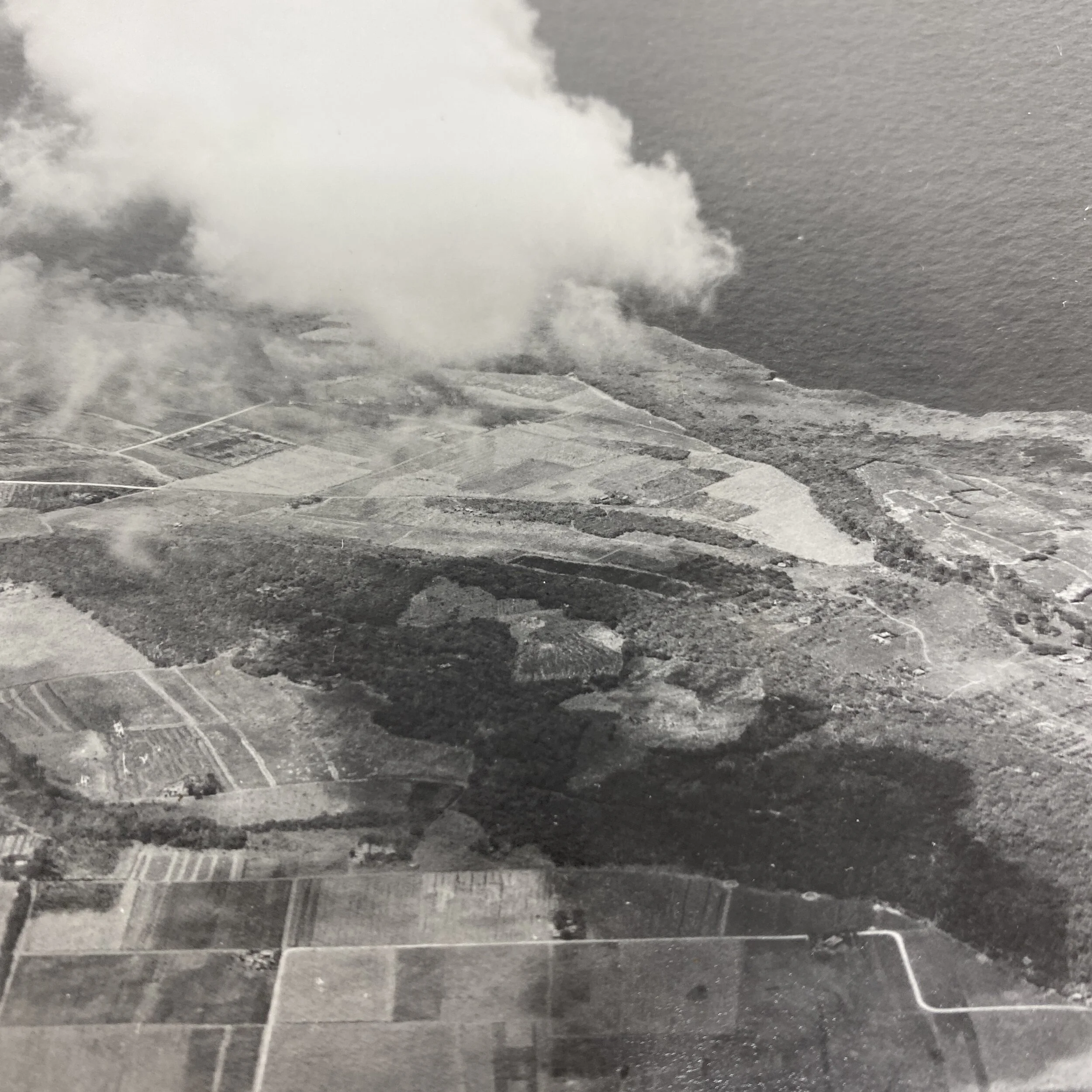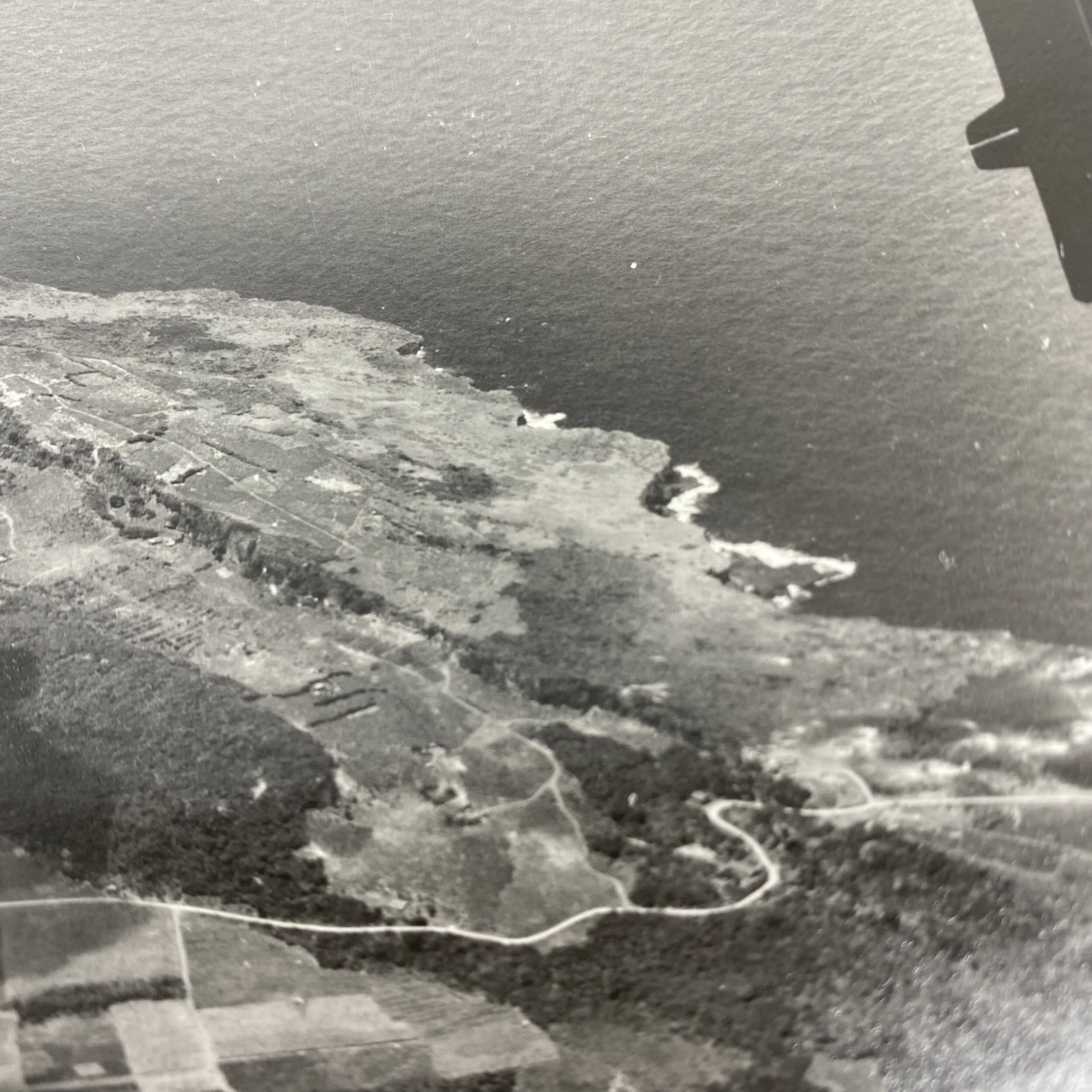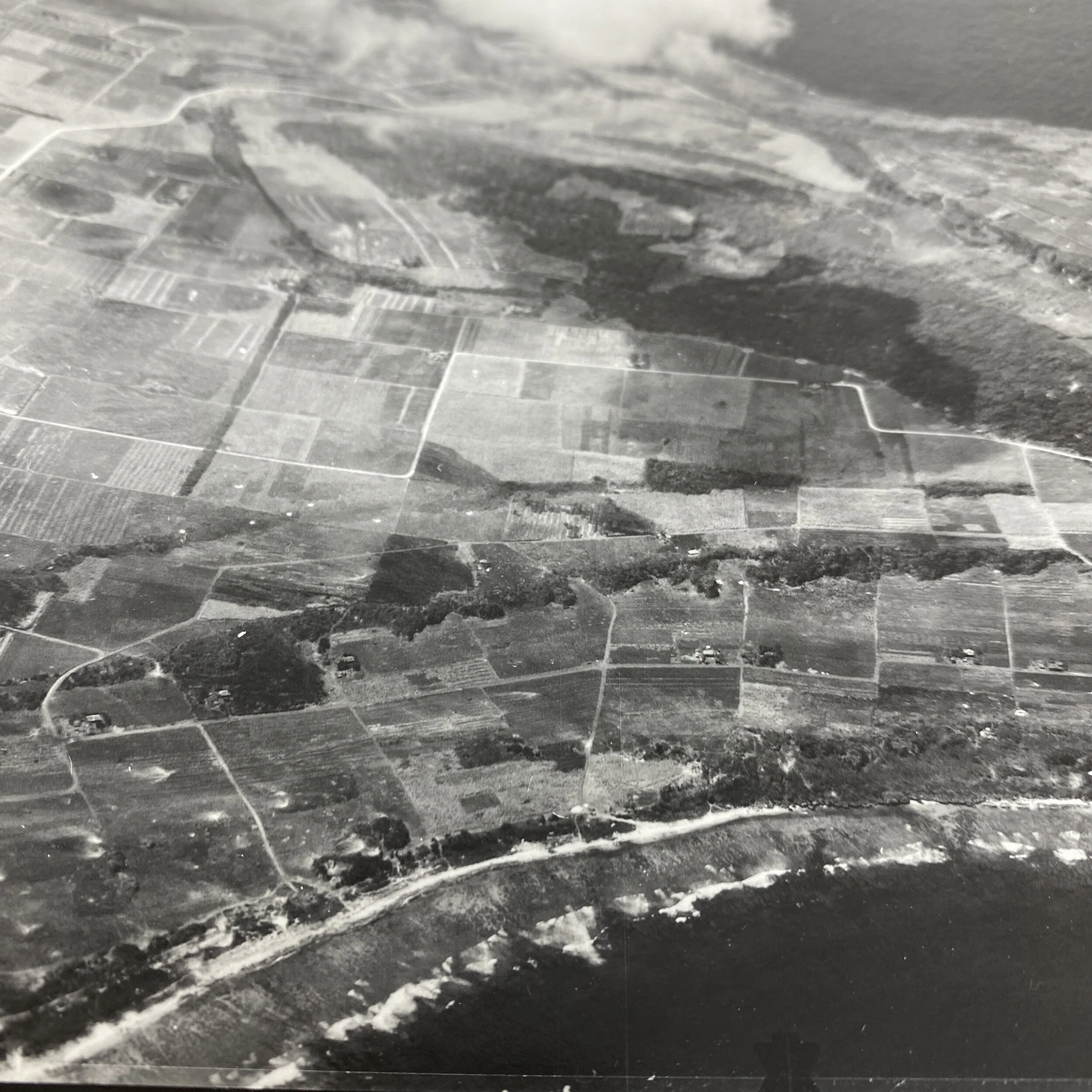D-1 Day June 1944 Dated - “Saipan - Aslito Airfield and Vicinity” - U.S.S. Enterprise CV-6 Aerial Reconnaissance Photograph












D-1 Day June 1944 Dated - “Saipan - Aslito Airfield and Vicinity” - U.S.S. Enterprise CV-6 Aerial Reconnaissance Photograph
Size: 7.5 x 7.5 inches
Letter of Authenticity included.
Taken 1 day before the D-Day landing on Saipan.
Dated June 14, 1944 this original ‘CONFIDENTIAL’ World War II USS Enterprise aerial reconnaissance photograph is marked “Saipan - Aslito Airfield and Vicinity” and was taken by a U.S.S. Enterprise air group pilot and is also labeled with “CV6”. Taken with a K-17 aerial camera, the K-17 camera was originally designed as an all-purpose aerial camera and was used widely throughout World War II for vertical mapping, photography, and all types of aerial reconnaissance intelligence and bomb damage assessment.
Following the pilots combat mission in the area, and their safe landing aboard the deck of the USS Enterprise this photograph was then developed aboard the carrier’s photographic development crew and was marked, used, and examined by USS Enterprise pilots (such as Lt. Moore) and other USS Enterprise high ranking commanders and officers.
USS Enterprise and Saipan:
G5-4. After a month of relative inactivity, ENTERPRISE departed Majuro on 6 June with Task Group 58.3 to support landings on Saipan. Her first fighter sweeps were sent against the Island on 11 June and continued for the next three days. On 15 June the landings took place, supported by carrier planes and bombardment by surface ships. While repulsing an air attack, superficial damage to superstructure was sustained when a 40mm shell from a U.S. vessel struck ENTERPRISE.
G5-5. It was suspected that the Japanese Fleet was in the vicinity, and during 17 and 18 June the U.S. ships worked around to the west of Saipan, searching for the enemy fleet. On 19 June the U.S. task group was attacked by more than 400 Japanese dive bombers and torpedo planes, the majority of them carrier type aircraft. So effective were the combat air patrol and anti-aircraft defense, that approximately 366 enemy planes were destroyed, ENTERPRISE fliers accounting for 19. Unfortunately search planes could not discover the Japanese naval force until the afternoon of the twentieth, some 670 miles west of Saipan. Moderate damage was inflicted on the enemy and one carrier was sunk. The Japanese retired rapidly westward so that, although contact was maintained by search planes through the following day, the distance was too great to launch a strike. ENTERPRISE and the other U.S. vessels then returned closer to Saipan from where she launched daily strikes against Guam between 28 June and 5 July. She returned to Eniwetok on 9 July and from Eniwetok proceeded to Pearl Harbor where she had availability at the Navy Yard from 16 July to 3 August.
USS Enterprise Action Report Log from June 14, 1944:
D-1 DAY (14 June 1944).
CAP#2 (0745-1000).
8 VF - routine patrols.
ASP#2 (0745-1000).
7 VB - routine patrols.
Strike C (0915-1100)
14 VF, 9 VB and 9 VT - 2 VF furnished Air Coordinator #3; CHARAN-KANOA set afire with incendiaries, gun positions in south central part of SAIPAN strafed and bombed. 9.9 tons of bombs dropped.
Strike D (0940-1230).
4 VF and 2 VB - the 4 VF furnished Air Coordinator #4 and strafed small boats off CHARAN-KANOA; VB bombed gun positions southwest of ASLITO airfield. 1 ton of bombs dropped.
Strike G (1215-1530).
12 VF, 9 VB and 9 VT - 1 VB furnished Air Coordinator #6; AFETNA POINT, SAIPAN was bombed and strafed and at least two fires started; sugar mill at CHARAN-KANOA was set afire and destroyed by incendiaries and bombs; propaganda leaflets were distributed over SAIPAN. 9.9 tons of bombs dropped.
Strike I (1345-1655).
2 VF and 8 VB - the two VF furnished Air Coordinator #7; radar station on MT. TAPOTCHUA, gun positions north of AGINAN POINT, SAIPAN, and barracks and planes at ASLITO airfield bombed and strafed. 4 tons of bombs dropped.
Miscellaneous.
2 VF(N) went on rescue escort mission (0910-1235) - no action.
1 VT made trip to SAN JACINTO and returned (1345-1530).
1 VB landed on LEXINGTON to remain overnight (1808).
2 VT made several message drops (1345-1655).Recapitulation for D-1 Day.
Launchings 103 Landings102 Bombs Dropped (tons)24.8
Action Report and Log from USS Enterprise from June 6-29th, 1944:
On 6 June 1944, ENTERPRISE, as a unit of Task Group 58.3 (Rear Admiral J.W. Reeves, Jr., USN, Commander Carrier Division FOUR, U.S.S. ENTERPRISE, Flagship) departed Majuro Atoll, and proceeded in accordance with reference (b) toward Saipan, Mariana Islands. At 1300 on 11 June 1944 at a point 229 miles East of Saipan, this vessel launched a fighter sweep to start the combat actions connected with the occupation of Saipan. Description of subsequent actions naturally divides itself into three phases corresponding to the developments.
First Phase - Bombardment and Invasion of Saipan.
From 11 June to 17 June 1944, ENTERPRISE conducted air operations in the area as ordered. Repeated strikes were launched to eliminate enemy air opposition, to destroy AA and coast defense guns and defenses, and to provide air support for the amphibious landing and advance of our ground troops in the seizure of Saipan.
At dusk on 15 June, Task Group 58.3 was vigorously attacked by a formation of Jap torpedo planes. The group of seven VB(M) made a determined attack on our port bow, meeting a tremendous volume of fire from the Task Group, six planes going down in flames.
ENTERPRISE shot down two and assisted on a third. A bomb from an undetected plane exploded in the water about 750 yards ahead on the port bow just before the torpedo planes reached that point. One torpedo plane dropped a torpedo about 1000 yards on the port bow, the torpedo running parallel to the ship at a distance of about 50 yards. One man was killed and 10 suffered slight shrapnel wounds from cross fire coming from other ships.
Strikes on Guam were conducted on 17 June in addition to refueling.
Second Phase - Engagement with the Japanese Fleet.
Action with the Japanese appearing imminent, the Task Group reformed and sought contact. On 17 and 18 June, ENTERPRISE launched 325 mile searches to the westward which were negative. At 0200 on 19 June, fifteen torpedo planes were launched on a special 300 mile night radar search and attack mission. No contact was made. Starting about 1030 Task Force 58 was attacked by the aircraft of the Japanese Fleet in successive waves. The flight deck was cleared. ENTERPRISE fighters joined the Combat Air Patrol in intercepting the Jap attacks, and the Bomber and Torpedo planes bombed Orote Airfield on Guam. The task force fighters shot down most of the attacking enemy planes, ENTERPRISE VF claiming 19. A few enemy planes were able to make attacks on this group of ships. These were shot down spectacularly by ships' gunfire, ENTERPRISE claiming destruction of one plane and assisting in two others. One of our VF planes was shot down over Guam.
Early on 20 June, a 325 mile search was launched, with negative results. On the second search at 1547 ENTERPRISE planes made contact report on the Jap Fleet bearing 287° (T) distance 214 miles. At 1624 a strike of 12 VF, 5 VT, 11 VB was launched. Ten direct hits are claimed on two enemy carriers with several damaging near misses on these ships and a CVE. It is believed on HAYATAKA class carrier was probably sunk. A ZUIHO class carrier was severely damaged, a CVE damaged by near misses, and 12 enemy planes were shot down. It was very dark when the striking group returned with little fuel left. All but five ENTERPRISE planes landed safely aboard various carriers, and the personnel of the five planes were recovered from water landings by destroyers. One VF pilot shot down over the target was recovered by rescue seaplane.
At 0230, 21 June ENTERPRISE launched two VT planes to regain contact with the Jap Fleet and trail it. These planes carried out their mission, reporting accurately the composition of the remaining Jap Forces, which was at a distance outside the range of the search and attack group of 12 VF, 8 VB, 8 VT launched at 0605. All carriers reshuffled to recover own planes. Rescue operations were singularly successful.
Third Phase - Neutralization of Guam and Pagan Islands.
From 21 June to 29 June, the Task Group carried out strikes as ordered on Guam and Pagan Islands to neutralize the airfields and destroy defense guns and military installations. Successful night interceptions were made in an attempt to cut off Jap planes flying into the Marianas from the Southwest, three enemy planes being thus destroyed on the night of 28 June and one on the night of 27 June 1944.
The entire action resulted in the loss of sixteen aircraft of this vessel, eight lost in combat and eight operationally. Four pilots were killed or are missing and three air crewmen were killed or are missing.
Comprehensive WWII combat history of USS Enterprise (CV-6):
The Yorktown class aircraft carrier, USS Enterprise (CV-6) was commissioned at Newport News, Virginia, on May 12, 1938. Relocating to the Pacific, she was at sea during the Japanese Attack on Pearl Harbor on December 7, 1941. Three days after, she became the first U.S. Navy warship to sink a Japanese warship, submarine I-70, and later that month participated in the Wake Island expedition. In April, Enterprise covered the Dootlittle Raid on Japan and participated in the Battle of Midway that June, where her planes helped sink three Japanese aircraft carriers and a cruiser. During the Guadalcanal Campaign, she covered the landings and participated in the battles of Eastern Solomons and Santa Cruz Islands. Despite being damaged in both battles, she launched aircraft to assist the ships involved in the Naval Battle of Guadalcanal. In late 1943 and early 1944, Enterprise took part in the Gilberts and Marshall invasions and air attacks on the Japanese in the Central and Southern Pacific. In the summer of 1944, she participated in the Marianas operation and the Battle of the Philippine Sea, followed with the largest naval battle in history, the Battle of Leyte Gulf in October.In February 1945, Enterprise took part in the Iwo Jima invasion, then raids on the Japanese home islands and the Okinawa campaign in April. Due to damage received by two kamikaze attacks in April and May, she returned to the United States with the distinction of being the most decorated U.S. Navy warship during the war. Following Japan's surrender, she helped transport U.S. servicemen back to the United States. Decommissioned in February 1947, Enterprise was re-designated (CVA-6) in October 1952 and then to (CVS-6) in August 1953. Despite efforts to turn her into a museum ship, she was sold for scrapping in July 1958.